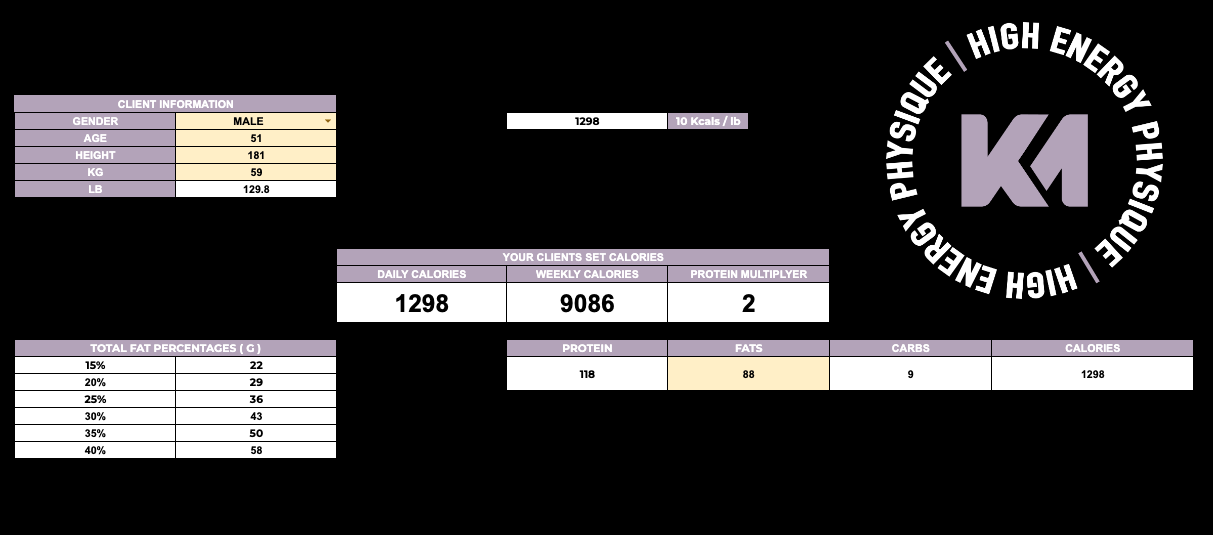How many calories should i eat if I want to lose fat?
So you’ve decided it’s time for you to lose weight. Getting on top of your nutrition is going to be the most important factor that will determine success with your efforts. In this article we’ll go through the following:
The purpose of the meal plan
Determining your number of Calories
Determining your Macronutrient Ratios
Gut health considerations
The importance of keeping it simple
What to eat
Creating your meal plan
THE PURPOSE OF THE MEAL PLAN
The Meal Plan is there to give some structure to your meals. It’s there to teach you to know what you should be prioritising in each meal. We’re not giving you a plan for life, but essentially your best practices.
There are occasions where you won’t be able to stick to your meal plan. But don’t worry, you’ll know about these occasions in advance and we’ll give you a plan for such days.
That being said, knowing what and how much you usually eat, will help us in scenarios where we need to go off plan.
So this is an essential activity to perform.
STEP 1 - Figure Out Your Calories
When it comes to setting up your nutrition plan for fat loss, simplicity is key. There's no need to get bogged down with complicated equations like Katch-McCardle, Harris-Benedict, or Mifflin-St Jeor. These equations estimate your calorie needs based on factors like age, gender, weight, height, and activity level.
However, remember, these are just estimates—a starting point.
Since these numbers are starting points, we'll need to make adjustments based on your progress.
That's why I prefer a straightforward approach to determine your initial calorie intake. We'll only know if we need to tweak things if your weight loss is more or less than 1% of your body weight per week.
Let's keep it simple. The formula we’re going to use is:
Total KCal= 10 × Your Bodyweight in lb
Get access to the calculator pictured above, here
This formula gives a lower calorie number, which might seem too low for some of you.
Truth is, we won’t know until we see how your weight reacts.
If your weight drop is more than the targeted 1% of your bodyweight per week, we can give you more food. Usually in the form of carbs.
The most important thing to understand is that this is a starting point.
STEP 2 - Figure out your macros
After we’ve got your total calories, it's time to portion these amongst the three macronutrients: protein, fats and carbohydrates.
To simplify their roles:
💪 Protein: Essential for feeling full and maintaining muscle mass.
🥑 Fats: Important for hormone health and adding variety to your meals.
🏋️ Carbohydrates: Crucial for sustaining high-quality training sessions.
The table below illustrates how we figure the amount in grams for each macronutrient.
STEP 3 - GUT HEALTH CONSIDERATIONS
This is talked about more in this article.
However, we’re looking to ensure that in terms of fibre, we’re hitting these numbers:
Fibre recommendations for Males and Females.
We also want to ensure that we include probiotics.
These are live beneficial bacteria that help maintain the natural balance of microorganisms in your intestines.
Finally prebiotics are types of dietary fiber that feed these good bacteria.
STEP 4 - KEEPING IT SIMPLE
The most important consideration with your meal plan, is to keep it simple.
This minimises decision fatigue and keeps you on track.
My recommendation is as follows
2 Options for Breakfast
4 Options for Lunch/Dinner
2 Options for Snacks/Pre & Post Workout
I recommend keeping these consistent for a week or two before changing.
We should never decide to switch things up during the week. This is where things can go off track.
STEP 5 - WHAT TO EAT
The table below gives a sample of the foods we should be eating for each category discussed so far.
STEP 6 - CREATE YOUR MEAL PLAN USING MYFITNESS PAL
We’re going to take the macros below and turn them into meals.
We start by entering the foods we want to include from each of the columns from step 5 into MyFitnessPal.
Once done, we check the macro totals to see how close we are.
After that- we make adjustments, if needed, until we hit the macros desired.
Understanding the Bigger Picture
Remember, fat loss is a gradual process. You won’t see drastic changes overnight.
The goal is to find a sustainable calorie intake that allows you to lose fat without feeling deprived or drained. The initial number is just a starting point.
By keeping things simple, you can focus more on consistent action rather than getting lost in complex calculations.







